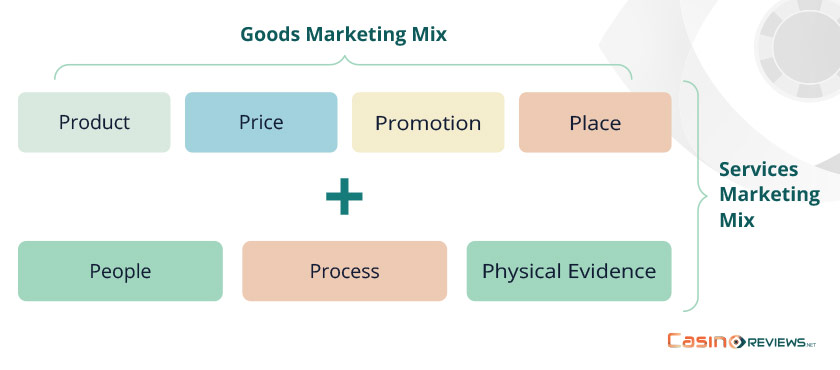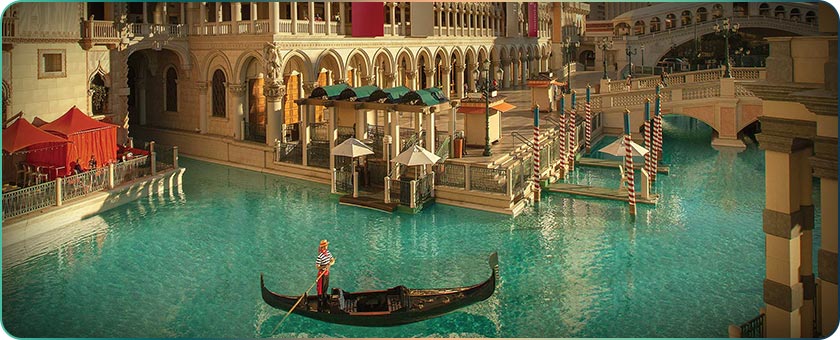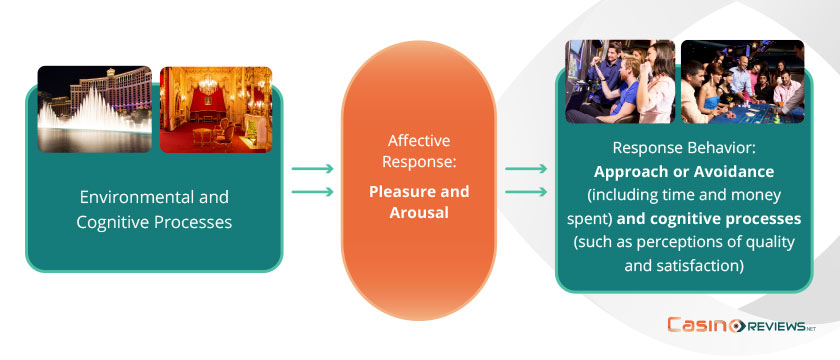The Extended Marketing Mix for Casinos - People, Processes, and Physical Evidence

The casino setting is one where people’s emotions principally drive their gaming-related behaviors. Seasoned casino executives orchestrate the interplay of their employees, business processes, and the physical evidence presented to customers with this realization in mind. Optimal financial outcomes are dependent upon enthusiastic, well-trained, and engaged employees, business processes that provide efficiency in operations and customer satisfaction, and physical evidence that is both inviting and pleasurable for customers.
Introduction
In Part 1 of this two-part series, we alluded to the unique characteristics of services such as intangibility, inseparability, heterogeneity, and perishability. Given these differences, the traditional marketing mix for physical goods comprising of the 4Ps of Product, Price, Promotion, and Place is insufficient (though necessary) to address the scope of decision-making for services such as casinos. While Part 1 addressed the classical four Ps of marketing, we shall now discuss the three Ps that make up the expanded marketing mix: People, Processes, and Physical evidence. Each of these Ps has a huge impact on the quality of customer experience in casinos.

Figure 1: The Extended Marketing Mix for Services
The people element of the expanded marketing mix includes employees and immediate customers. This element directly reflects the inseparability dimension of services wherein the service is simultaneously produced and consumed and where the service recipient is typically present at the service premises and directly interacts with the service provider.
In a service setting such as a casino, the operator needs to carefully manage interactions between service personnel (such as security staff, dealers, and slot attendants) and customers, as well as manage interactions between the customers themselves. A drunk and disorderly patron at a blackjack table will ruin the gaming experience for other players at the table. A loud customer at a Michelin Star restaurant within an integrated resort will create an unpalatable dining experience for other customers.
The attitudes and skills of casino frontline employees substantially impact customer satisfaction and customer experience. Casinos, therefore, need to exercise the utmost care in recruiting, selecting, training, supporting, and rewarding employees. Managers also need to ascertain that employees possess the requisite technical and interpersonal skills for the job.
In the Service-Profit Chain Model, James Heskett and his co-authors contend that when service companies put employees and customers first, there is a big change in the way they manage and measure successi. Service-Profit Chain proponents relate profitability, customer loyalty, and customer satisfaction to the value created by satisfied, loyal, and productive employees. Heskett et al. write,
Top-level executives of outstanding service organizations spend little time setting profit goals or focusing on market share… Instead, they understand that in the new economics of service, frontline workers and customers need to be the center of management concern. Successful service managers pay attention to the factors that drive profitability… investment in people, technology that supports frontline workers, revamped recruiting and training practices, and compensation linked to performance for employees at every level.
During the COVID-19 pandemic, almost every gaming establishment experienced closure of facilities. Most operators furloughed their employees in response. These employees lost their source of livelihood with little advance notice. Some operators, in places like Macau, brought pressure on their employees to take unpaid leave, thus causing financial distress to the employees and their families.
When casinos reopened, many employees refused to go back to their original employers. They realized that senior management regarded them not as human beings but as just another factor of production that can be easily dispensed with. The few operators who kept their frontline staff on payroll even during tough times were amply rewarded by way of employee loyalty and high productivity. Research suggests that there is a strong positive relationship between employee engagement and customer satisfaction.ii
Process
The processes element of the extended marketing mix defines the way in which various services offered by a casino are produced and delivered. It includes service delivery and operating systems. A well-designed and well-executed process in the marketing mix:
- Increases operational efficiency
- Offers convenience to customers
- Reduces the cost of offering services
- Improves the efficiency of service delivery.
Effectively, it helps in achieving the goal of customer satisfaction. Effective service processes are important in overcoming the problems created by inseparability between service production and consumption and customer involvement in the service delivery. Relevant services processes should also address the heterogeneity of services and the variability in service encounters arising from the human element.
Let’s look at heterogeneity with regard to croupiers’ performance at a blackjack table. A well-trained and seasoned dealer will be able to deal sixty blackjack hands at a full table (comprising seven boxes). A dealer not so adept will probably deal only about forty hands. Assuming that all players utilize basic strategy, have an average bet of $50, and a house advantage of 0.5%, the difference in dealer performance is as follows:
- Dealer 1: 50 x 60 x 7 x .005 = $105/hour
- Dealer 2: 50 x 40 x7 x .005 = $70/hour
If both dealers work forty hours a week and fifty weeks in a year, Dealer 1 will generate $210,000 for the casino, whereas Dealer 2 will generate only $140,000. Smart casino managers will ensure that they get their dealers up to speed without detracting from customer satisfaction.
Streamlined standardized processes assist in overcoming variability and lead to efficient service delivery. However, in many situations, a more flexible approach that allows for greater customization of the service is needed. In the context of casinos, flexibility is especially important in dealing with high rollers. Several estimates suggest that high rollers account for more than 85% of a casino’s revenues. Therefore, many casinos will alter their rules, processes, and house advantage to appeal to high rollers.
In the game of baccarat, for instance, high rollers are allowed to open the cards dealt to them. Most Asian customers will blow at the cards to wipe out the dots and crumple and tear the cards if the value of the cards is not what they wanted. This ritual, which has absolutely no impact on the game outcome, serves to slow down the game considerably, resulting in lost revenue for the casino. However, casinos put up with these shenanigans to keep their customers happy. In low-limit baccarat tables, it is the dealer who opens the cards.
We mentioned earlier that the typical house advantage in blackjack is about 0.5 percent for a basic strategy player. However, casinos often alter the house advantage by changing the number of decks, altering payout on blackjack, and tweaking rules related to doubling or splitting a hand.
In many Las Vegas casinos, such tweaking reduces the house advantage to 0.255% at a table with a $100 minimum bet and increases it to 1.998% at a table where the minimum bet is $10. Similarly, French roulette (1.35% house edge) might only be offered to players who bet $50 or more per turn, while American roulette (5.26%) is made available to all of the lower rollers who wager less than $50. High rollers are typically very well informed about the rules and processes at various casinos and will frequent those casinos that provide them with maximum flexibility and lowest house edge for the casino.
Physical Evidence
The intangibility and inseparability characteristics of a casino’s offerings underscore the importance of the physical evidence. Physical evidence concerns the tangible evidence that customers get to see and sense. This includes the appearance of the service environment or the casino servicescape (e.g., décor, equipment, ambiance, layout, signage, and so on) and service personnel (e.g., appearance and dress), as well as company website, stationery, cutlery, and so on. These servicescape elements influence the way in which the service is received and delivered. Physical evidence provides customers with important clues for evaluating service quality.
Casino companies place a lot of emphasis on their servicescape. The gondolas at the Venetian in Las Vegas (Figure 2) and Macau, the dancing fountains at the Bellagio in Las Vegas (Figure 3), the Tree of Prosperity at Wynn Macau, and, more recently, the Stadium Swim at the Circa in downtown Las Vegas are all creations designed to favorably impact the attitude and mood of customers.

Figure 2: The gondolas at the Venetian hotel in Las Vegas

Figure 3: The dancing fountains at the Bellagio hotel in Las Vegas
Elements such as music, scents, temperature, and humidity also have a significant impact on how long a customer stays in the casino, how much they gamble, and their overall satisfaction with the experience.
The impact of the physical environment on moods and behavior is best explained by Mehrabian and Russell’s (1974) Stimulus-Response Modeliii (Figure 4). This model posits that people’s perception of the environment—both conscious and unconscious—influences how they feel in a particular setting. These feelings, in turn, drive their responses to the environment. The typical response to the environment is “approach” or “avoidance.” Approach suggests comfort and satisfaction with the environment, whereas avoidance indicates wanting to move away from the environment.
Russell’s Model of Affect further suggests that emotional responses to the environment can be mapped along two main dimensions—pleasure and arousal. Pleasure signals how much an individual likes or dislikes the environment, whereas arousal refers to the level of stimulation experienced within the environment. Sights, sounds, and music, the integral features of modern-day slot machines, are all designed to stimulate arousal.

Figure 4: Mehrabian-Russell Model of Environmental Responses (Adapted from Jochen Wirtz and Christopher Lovelock [2016] Services Marketing, 8th Ed., Singapore: World Scientific)
Both pleasure and arousal are subjectively determined, and it is therefore important that the servicescape resonates with the demographic and psychographic profile of the target market. Also, the various elements of the servicescape need to be internally consistent. Low arousal music goes well with low arousal scent, and high arousal music with high arousal scent. Mixing discordant stimuli such as low arousal music and high arousal scent is a recipe for disaster.
Conclusion
Part 2 of the extended services marketing mix covered the elements of people, process, and physical evidence. These three elements were added to the classical marketing mix because of the inseparability and variability aspects of services.
Each of these three elements has a strong impact on how services are delivered by casinos. People element determines the casino’s productivity and rapport with customers. Casino employees have a strong influence on customer satisfaction and retention.
The processes used by casinos can be a source of sustainable competitive advantage. Well-conceptualized processes ensure that the customer journey delivers satisfaction at key touchpoints and that the journey is seamless across touchpoints. Well-mapped processes—along with well-trained employees and the right technology—creates a service that is profitable as well as customer-oriented.
Finally, the physical evidence within a casino setting triggers feelings of approach and avoidance for employees and customers alike. The casino environment should trigger pleasure and arousal among visitors. Consistency across various elements of the physical environment is crucial, particularly as it applies to music and scents.
Read more:
i James L. Heskett, Thomas O. Jones, Gary W. Loveman, W. Earl Sasser Jr. and Leonard Schlesinger (1994), “Putting the Service Profit Chain to Work,” Harvard Business Review, 72 (March-April), 164-174.
ii Sadia Cheema, Asia Akram, and Farheen Javed (2015), “Employee Engagement and Visionary Leadership: Impact on Customer and Employee Satisfaction,” Journal of Business Studies Quarterly, 7 (2), 139-148.
iii Albert Mehrabian and James A. Russell (1974). An Approach to Environmental Psychology. Boston, MA: MIT Press.





Review this Blog
Leave a Comment
User Comments
comments for The Extended Marketing Mix for Casinos - People, Processes, and Physical Evidence